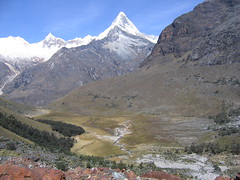Mountains and Valleys, Donkeys and Cows

On the very first day of this hike, before I even started, I had realized that the amount of weight I was carrying in my pack was too much for me. I could carry it, but I wouldn´t enjoy the hike, and I´d be really, really tired. So, when I arrived at the trail head and found a group waiting to depart with donkeys and guides, I jumped on the opportunity and negotiated with the chief guide to have them carry some of my stuff. I was more than pleased to pay a bit under $4 per day to have my tent, sleeping bag and mat and some clothing strapped to a donkey´s back. Thus relieved, I headed down the trail after the group.
Hiking in Peru is different from my experiences in Argentina and Chile, in that here, tourists that hike often do it through an agency. This group was made up of 9 people about my age; they had 6 donkeys, 2 arrieros (donkey-handlers) and two or three guides. Each person carried a small day pack, the donkeys carried the rest, as well as the tents and the food. Their tents were set up before they arrived and taken down in the mornings, and the guides prepared and served all their meals. (Luckily for me, they let me join them in their food tent to play cards at night, though I didn´t get to have any of their roast chicken or french fries.) Neither the people in the group, nor their guides, could believe that I wanted to do it myself. In Peru, if you can afford it, you pay for a donkey to carry your things. Here, manual labor is a way of life, not something to be done for sport. What a priveliged life we gringos lead that we think carrying heavy loads on our back is something to do for fun!
At the beginning of the first day, I got a tiny bit lost, and stopped at a farmhouse to ask directions. This was rural, and very poor, Peru! The woman I asked first spoke no Spanish, only Quechua. When I got up to the house, the man inside had very few teeth, and had to pull himself towards the door with his hands before he could pull himself to his feet. He gave me directions as three curious children with filthy clothing and feet watched from behind the wall. Later that day I went through a field where two sisters, aged 3 and 4, were herding their family´s goats. They only knew enough Spanish to ask me for money and candy.
On the second day we had a very hard climb up to the highest point on the trail: Punta Union, at 4,750 meters, or about 15,400 feet. This is close to the highest altitude I´ve been at during my entire trip, and I did it on foot! It was very very difficult, but the view at the top was spectacular. After cooking dinner on the second night I had left my dirty cooking pot outside my tent, and woke up at 1 AM to the sounds of something licking it clean and then rooting through my bag of garbage. It was a cow! I had to repeatedly knock on the sides of the tent to get it to go away, and even then it kept coming back, even after I moved the pot and food inside the tent. The third day was very long, and although beautiful, there was a punishing wind in the valley and after nearly 8 hours my feet were crying out for rest. That night, I had a friendly donkey next to my tent as I cooked, trying to steal my food.
Today was a relatively easy day, just two hours hiking downhill to the end of the trail. I got there before the group (and before the burros with my stuff) and had time to do like the Peruvians do, washing myself and my sweaty clothing in the river. But nothing ruins the fresh feeling of having washed in a glacial river like spending 4 hours in Peruvian public transportation. At one point I was crammed into the back seat of a station wagon with three other passengers, who chattered away with the driver and two passengers in the front in very animated Quechua--although the word "gringa" appeared in their conversation more often than I would have liked. In the back of the station wagon were about 25 giant squash, on their way to the market in Caraz. I suppose I was lucky--as we traveled along the curves of the cliffside road (giving amazing views of the Huaylas canyon), we passed several other cars, one of which was a station wagon like ours, with two passengers in front, four in back, and in the way back, what appeared to be a family of five.












<< Home